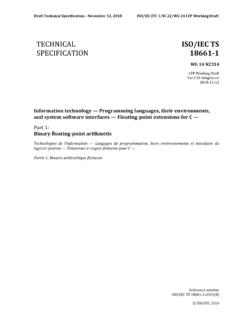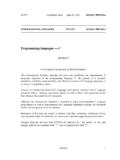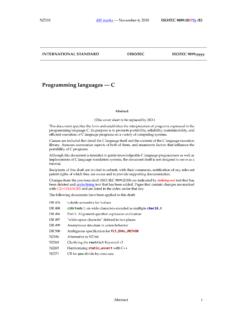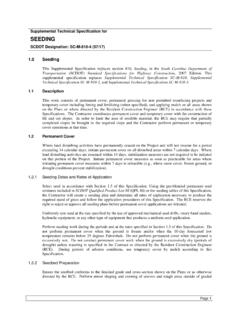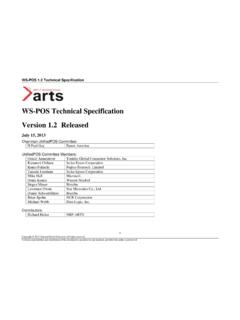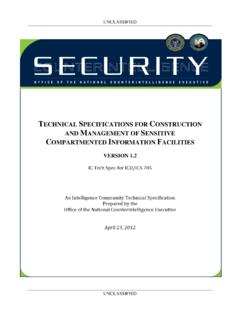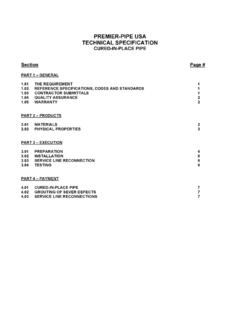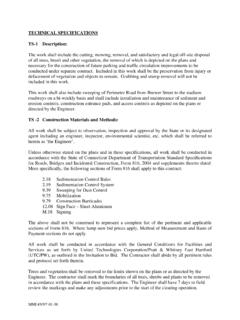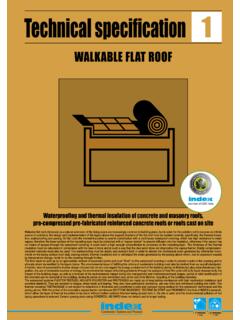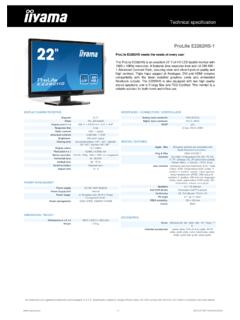Transcription of TECHNICAL ISO/IEC TS SPECIFICATION 18661-1 - open-std.org
1 Draft TECHNICAL SPECIFICATION May JuneNovember 123022, 20186 ISO/IEC JTC 1/SC 22/WG 14 CFP Working DraftNnnnn ISO/IEC JTC 1/SC 22/WG 14 N1809 Date: yyyy-mm-dd Reference number of document: TECHNICAL ISO/IEC TS SPECIFICATION 18661-1 WG 14 N2315 Committee identification: ISO/IEC JTC 1/SC 22/WG 14 Secretariat: ANSI CFP Working DraftSecond edition For C2X integration 201y-mm-dd2018-11-12 Information Technologytechnology Programming languages, their environments, and system software interfaces Floating-point extensions for C Part 1: Binary floating-point arithmetic Part 1: Binary floating-point arithmetic Technologies de l information Langages de programmation, leurs environnements et interfaces du logiciel syst me Extensions virgule flottante pour C Partie I: Binaire arithm tique flottante Warning This document is not an ISO International Standard. It is distributed for review and comment.
2 It is subject to change without notice and may not be referred to as an International Standard. Recipients of this draft are invited to submit, with their comments, notification of any relevant patentPartie 1: Document type: TECHNICAL SPECIFICATION Document subtype: Document stage: (20) Preparation Document language: E Binaire arithm tique flottante Reference number ISO/IEC TS 18661-1 :2014(E) ISO/IEC 2016 ISO/IEC 2014 All rights reserved TECHNICAL SPECIFICATION March 21, 2014 5 ISO/IEC 2016 10 All rights of which they are aware and to provide supporting documentation. COPYRIGHT PROTECTED DOCUMENT ISO/IEC TS 18661-1 TECHNICAL SPECIFICATION March 21, :2014 CFP Working Draft WG 14 N1809(E) ii ISO/IEC 20142016 All rights reserved Copyright notice This ISO document is a working draft or committee draft and is copyright-protected by ISO. While the reproduction of working drafts or committee drafts in any form for use by participants in the ISO standards development process is permitted without prior permission from ISO, neither this document nor any extract from itreserved.
3 Unless otherwise specified, no part of this 5 publication may be reproduced, stored or utilized otherwise in any form or by any means, electronic or transmitted in any form for any other purposemechanical, including photocopying, or posting on the internet or an intranet, without prior written permission. Permission can be requested from either ISO. Requests for permission to reproduce this document for at the purpose of selling it should be 10 addressed as shownaddress below or to ISO s member body in the country of the requester:. ISO copyright office Case postale 56 CH-1211 Geneva 20 Tel. + 41 22 749 01 11 Fax + 41 22 749 09 47 E-mail Web Reproduction for sales purposes may be subject to royalty payments or a licensing agreement. Violators may be prosecuted. 15 WG 14 N1809 TECHNICAL SPECIFICATION March 21, 2014 ISO/IEC TS 18661-1 :2014(E)CFP Working Draft ISO/IEC 20142016 All rights reserved iii Contents Page Published in Switzerland Foreword.
4 Viv Introduction ..viiv 1 Scope .. 1 5 2 Conformance .. 1 3 Normative references .. 1 4 Terms and definitions .. 21 5 C standard conformance .. 2 Freestanding implementations .. 2 10 Predefined 2 Standard headers .. 3 6 Revised floating-point standard .. 65 7 Types .. 76 Terminology .. 76 15 Canonical representation .. 87 8 Operation binding .. 9 9 Floating to integer conversion .. 1514 10 Conversions between floating types and character sequences .. 1615 Conversions with decimal character sequences .. 1615 20 Conversions to character sequences .. 1716 11 Constant rounding directions .. 1817 12 NaN support .. 2524 13 Integer width macros .. 3129 14 Mathematics < > .. 3331 25 Nearest integer functions .. 3331 Round to integer value in floating type .. 3331 Convert to integer 3634 The llogb functions .. 3836 Max-min magnitude functions .. 3937 30 The nextup and nextdown functions.
5 4139 Functions that round result to narrower type .. 4241 Comparison macros .. 4644 Classification macros .. 4745 Total order functions .. 4947 35 Canonicalize functions .. 5049 NaN functions .. 5250 15 The floating-point environment < > .. 5351 The fesetexcept function .. 5351 The fetestexceptflag function .. 5452 40 ISO/IEC TS 18661-1 TECHNICAL SPECIFICATION March 21, :2014 CFP Working Draft WG 14 N1809(E) iv ISO/IEC 20142016 All rights reserved Control modes .. 5553 16 Type-generic math < > .. 5654 Bibliography .. 5957 5 WG 14 N1809 TECHNICAL SPECIFICATION March 21, 2014 ISO/IEC TS 18661-1 :2014(E)CFP Working Draft ISO/IEC 20142016 All rights reserved v Foreword ISO (the International Organization for Standardization) is a worldwide federation of national standards bodies (ISO member bodies). The work of preparing and IEC (the International Electrotechnical Commission) form the specialized system for worldwide standardization.
6 National bodies that are members of ISO or IEC participate in the development of International Standards is 5 normally carried out through ISO TECHNICAL committees. Each member body interested in a subject for which a established by the respective organization to deal with particular fields of TECHNICAL committee has been established has the right to be represented on that committee. Internationalactivity. ISO and IEC TECHNICAL committees collaborate in fields of mutual interest. Other international organizations, governmental and non-governmental, in liaison with ISO and IEC, also take part in the work. ISO 10 collaborates closely with the International Electrotechnical Commission (IEC) on all matters of electrotechnical standardizationIn the field of information technology, ISO and IEC have established a joint TECHNICAL committee, ISO/IEC JTC 1. The procedures used to develop this document and those intended for its further maintenance are described in the ISO/IEC Directives, Part 1.
7 In particular the different approval criteria needed for the 15 different types of document should be noted. This document was drafted in accordance with the editorial rules of the ISO/IEC Directives, Part 2 (see Standards are drafted in accordance with the rules given in the ISO/IEC Directives, Part 2. The main task of TECHNICAL committees is to prepare International Standards. Draft International Standards adopted by the TECHNICAL committees are circulated to the member bodies for voting. 20 Publication as an International Standard requires approval by at least 75 % of the member bodies casting a vote. ). Attention is drawn to the possibility that some of the elements of this document may be the subject of patent rights. ISO and IEC shall not be held responsible for identifying any or all such patent rights. 25 Details of any patent rights identified during the development of the document will be in the Introduction and/or on the ISO list of patent declarations received (see ).
8 Any trade name used in this document is information given for the convenience of users and does not constitute an endorsement. For an explanation on the meaning of ISO/IEC TS 18661 was prepared by specific terms and 30 expressions related to conformity assessment, as well as information about ISO's adherence to the WTO principles in the TECHNICAL Barriers to Trade (TBT) see the following URL: Foreword - Supplementary informationCommittee The committee responsible for this document is ISO/IEC JTC 1, Information Technologytechnology, Subcommittee SC 22, Programming languages, their environments, and system software interfaces. 35 ISO/IEC TS 18661 consists of the following parts, under the general title Information technology Programming languages, their environments, and system software interfaces Floating-point extensions for C: Part 1: Binary floating-point arithmetic Part 2: Decimal floating-point arithmetic 40 Part 3: Interchange and extended types ISO/IEC TS 18661-1 TECHNICAL SPECIFICATION March 21, :2014 CFP Working Draft WG 14 N1809(E) vi ISO/IEC 20142016 All rights reserved Part 4: Supplementary functions Part 5: Supplementary attributes Part ISO/IEC TS 18661-1 updates ISO/IEC 9899:2011 (, Information technology Programming languages, their environments and system software interfaces Programming Language C), Annex, annex F in particular, to support all required features of ISO/IEC /IEEE 60559.
9 2011 (, Information 5 technology Microprocessor Systems Floating-point arithmetic).. Part ISO/IEC TS 18661-2 supersedes ISO/IEC TR 24732:2009 (, Information technology Programming languages, their environments and system software interfaces Extension for the programming language C to support decimal floating-point arithmetic).. Parts 3 ISO/IEC TS 18661-3, ISO/IEC TS 18661-4, and ISO/IEC TS 18661-5 specify extensions to ISO/IEC 10 9899:2011 for features recommended in ISO/IEC /IEEE 60559:2011. ISO/IEC TS 18661-1 :2014(E)CFP Working Draft ISO/IEC 2016 All rights reserved vii Introduction Background IEC 60559 floating-point standard The IEEE 754-1985 standard for binary floating-point arithmetic was motivated by an expanding diversity in floating-point data representation and arithmetic, which made writing robust programs, 5 debugging, and moving programs between systems exceedingly difficult.
10 Now the great majority of systems provide data formats and arithmetic operations according to this standard. The IEC 60559:1989 international standard was equivalent to the IEEE 754-1985 standard. Its stated goals were the following: 1 Facilitate movement of existing programs from diverse computers to those that adhere to 10 this standard. 2 Enhance the capabilities and safety available to programmers who, though not expert in numerical methods, may well be attempting to produce numerically sophisticated programs. However, we recognize that utility and safety are sometimes antagonists. 3 Encourage experts to develop and distribute robust and efficient numerical programs that 15 are portable, by way of minor editing and recompilation, onto any computer that conforms to this standard and possesses adequate capacity. When restricted to a declared subset of the standard, these programs should produce identical results on all conforming systems.
